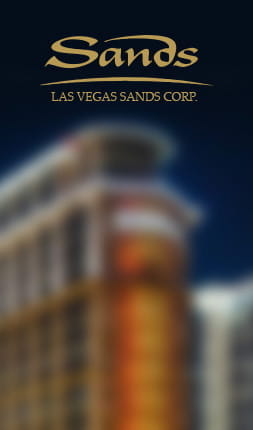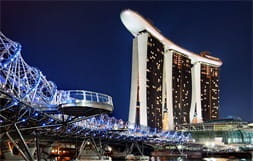Sands Las Vegas Casino
Prior to the advent of the modern resort casino-hotels, it was casinos such as the Sands that defined gambling on Las Vegas’ famous strip. Starting out as a casino with just a few hundred rooms in the Fifties, the Sands came to help define the all-in entertainment experience that is now at the centre of all major modern casinos around the globe.
From humble beginnings
As with many of Vegas’ great casinos of the period, the Sands emerged from humble beginnings. Designed by architect Wayne McAllister (who had designed both the El Rancho and Desert Inn casinos previously) and founded by Jakie Freedman, to begin with, the Sands was relatively small. When it opened in 1952, the premises consisted of little more than the casino itself and a few hundred hotel rooms.
Nevertheless, as the Fifties drew to a close, the Sands was already attracting some notable guests, such as then-senator (and future president) John F. Kennedy.
Glitz and glamour
 As the Fifties gave way to the Sixties, the Sands’ profile continued to rise. This was due in no small part to 1960 film Ocean’s Eleven, which was filmed at the casino.
As the Fifties gave way to the Sixties, the Sands’ profile continued to rise. This was due in no small part to 1960 film Ocean’s Eleven, which was filmed at the casino.
Naturally, the film itself helped to raise its profile. However, during the three weeks of filming there, some of its cast – Frank Sinatra, Dean Martin, Sammy Davis Jnr., Joey Bishop and Peter Lawford – all performed on stage together in the Casino’s Copa Room.
These performances were known as the Summit at the Sands, and are widely accredited as being the birthplace of the famous Rat Pack. Sinatra especially developed a fondness for it, even owning a stake in the Sands for a while.
This set to the tone for the years to come, with dozens of famous artists choosing to perform at the Copa Room. Indeed, some artists recorded live albums at this famous venue.
Expansion
In the mid-Sixties, famous American businessman, millionaire, film director, engineer and adventurer Howard Hughes took over the hotel. Hughes’ vision for Vegas’ future was to make the city more glamorous, and the Sands’ emerging reputation as one of America’s premier entertainment venues fitted perfectly with this.
Following the takeover, architect Martin Stern Jnr. was recruited to design a circular tower containing an additional 500 rooms.
The extension was opened in 1967, and the Sands became one of Vegas’ most memorable landmarks. Having left its mark on American popular culture, the Sands was now at its peak.
The Sands and the civil rights movement
Prior to the emergence of the mega-resorts in the Nineties, Las Vegas’ famous casinos had been a byword for mafia control and corruption. However, the Sands was able to do its part in bringing about some good to American society.
In the Fifties, the casino was notable for allowing famous African-American performer Nat King Cole to stay in the hotel and gamble in its casino. And in the Sixties, another African-American performer, Sammy Davis Jnr., convinced the Sands to hire more African-American staff, and permit them to enter the casino.
This may not sound like a big deal now. But in a society that was still split along racial lines, it was a clear step in the right direction.
Declining fortunes
The Sixties had unquestionably been kind to the Sands. However, the years that followed saw the casino gradually decline. Following Hughes’ death in 1976, the casino was sold in 1981. It then passed hands again several times over the coming years:
- 1967-1981: Howard Hughes
- 1981-1983: Inns of America
- 1983-1988: Summa
- 1988: Kirk Kerkorian/MGM
- 1988-1996: Sheldon Adelson & The Interface Group
This period of instability hit the Sands hard. By the start of the Nineties, the casino was already struggling to compete with other established casinos such as the Flamingo and Caesars Palace. And once Las Vegas’ mega-resorts started opening, the writing was on the wall for the Sands.
By the mid-Nineties, it became clear that the situation was beyond salvation. To the dismay of its staff and sentimental fans of the strip, the Sands was finally closed on June 30, 1996, and the main building imploded in a controlled explosion on November 26 that same year.
The casino was given one final hurrah of sorts, however. A plane was smashed into its soon-to-be-demolished lobby in 1997 for Nicolas Cage film Con Air. In many ways, this was a fitting final chapter for this famous casino, given that it had been another Hollywood blockbuster – Ocean’s Eleven – which had put it on the map in the first place.
A lasting legacy
 The Sands casino itself may be little more than a memory now in Las Vegas. However, this famous casino continues to live on in other forms.
The Sands casino itself may be little more than a memory now in Las Vegas. However, this famous casino continues to live on in other forms.
Given its prime location on the strip, Its demise allowed the Sheldon and his associates to build a grander, more modern mega-resort in its place, the Venetian. Further to this, their company now trades under the name Las Vegas Sands Group.
The group hasn’t been afraid to put this name to good use in other ways, either. Three of its most recent casinos-hotel resorts all bear the famous Sands moniker:
- The Sands Casino Macao (opened in 2004)
- The Marina Bay Sands, Singapore (2010)
- The Sands Casino Resort Bethlehem, USA (2009)
There have been others, too, such as the Sands Atlantic City. This had previously been known as the Brighton Hotel & Casino, but was renamed by then-owners Inns of America after the company bought the Sands Hotel in Vegas. However, any benefit was short lived. The casino filed for bankruptcy in 1998, and was formally closed on November 11, 2006 – almost ten years to the day when the Sands Hotel Las Vegas was demolished.
Sands Hotel facts & figures
Finally, here are some facts and figures relating to the casino:
- Address: 3355 Las Vegas Blvd, Las Vegas
- Opened: December 15, 1952
- Closed: June 30, 1996
- Total number of rooms: 715 (peak)
- Total number of slots: 1,100 slots
- Last owner: Sheldon Adelson & The Interface Group/Las Vegas Sands Corp.